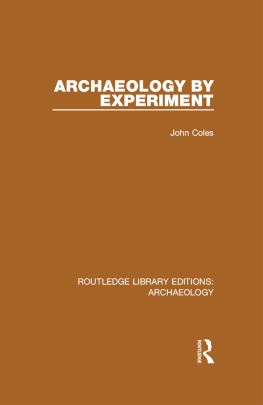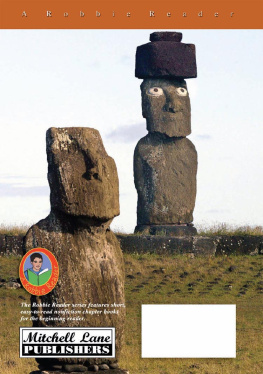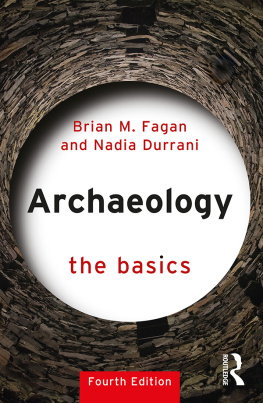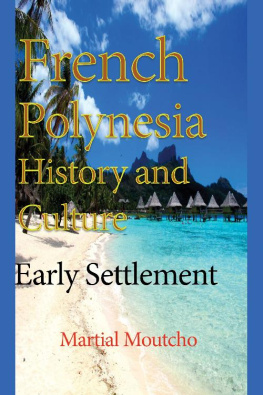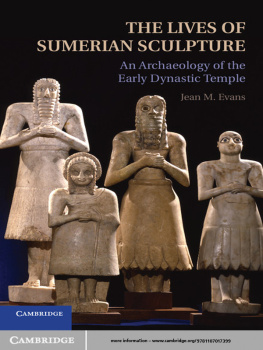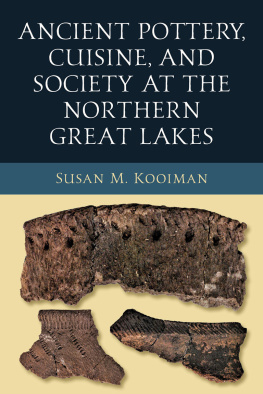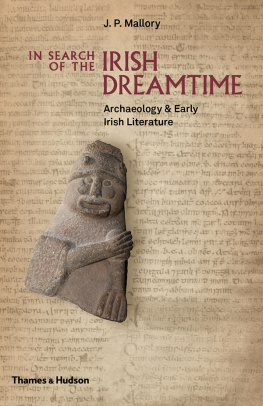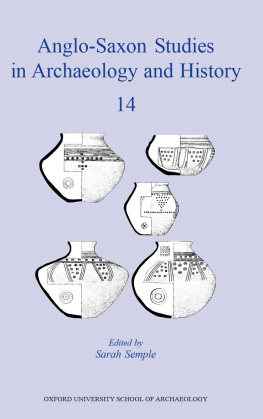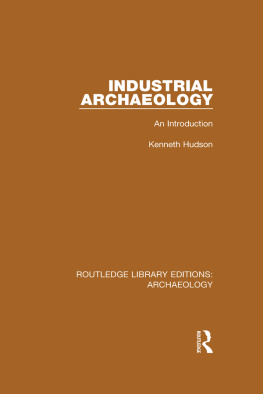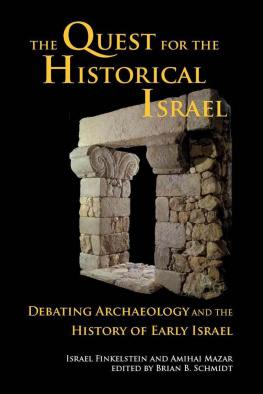
ROUTLEDGE LIBRARY EDITIONS: ARCHAEOLOGY
Volume 16
ARCHAEOLOGY BY EXPERIMENT
ARCHAEOLOGY BY EXPERIMENT
JOHN COLES

First published in 1973
This edition first published in 2015
by Routledge
2 Park Square, Milton Park, Abingdon, Oxon, OX14 4RN
and by Routledge
711 Third Avenue, New York, NY 10017
Routledge is an imprint of the Taylor & Francis Group, an informa business
1973 John Coles
All rights reserved. No part of this book may be reprinted or reproduced or utilised in any form or by any electronic, mechanical, or other means, now known or hereafter invented, including photocopying and recording, or in any information storage or retrieval system, without permission in writing from the publishers.
Trademark notice: Product or corporate names may be trademarks or registered trademarks, and are used only for identification and explanation without intent to infringe.
British Library Cataloguing in Publication Data
A catalogue record for this book is available from the British Library
ISBN: 978-1-138-79971-4 (Set)
eISBN: 978-1-315-75194-8 (Set)
ISBN: 978-1-138-81300-7 (Volume 16)
eISBN: 978-1-315-74844-3 (Volume 16)
Publishers Note
The publisher has gone to great lengths to ensure the quality of this book but points out that some imperfections from the original may be apparent.
Disclaimer
The publisher has made every effort to trace copyright holders and would welcome correspondence from those they have been unable to trace.
ARCHAEOLOGY BY EXPERIMENT
John Coles

HUTCHINSON & CO (Publishers) LTD
3 Fitzroy Square, London W1
London Melbourne Sydney Auckland Wellington Johannesburg Cape Town and agencies throughout the world
First published 1973
The paperback edition of this book is sold subject to the condition that it shall not, by way of trade or otherwise, be lent, re-sold, hired out, or otherwise circulated without the publisher's prior consent, in any form of binding or cover other than that in which it is published and without a similar condition including this condition being imposed on the subsequent purchaser
John Coles 1973
This book has been set in Times type, printed in Great Britain on smooth wove paper by Anchor Press, and bound by Wm. Brendon, both ofTiptree, Essex
ISBN 0 09 116870 8 (cased)
0 09 116871 6 (paper)
CONTENTS
I have received advice and encouragement from a number of archaeologists and others, and I am grateful for this interest. Among many, I particularly thank Mr Hans-Ole Hansen, Historisk-Arkaeologisk Forsogscenter, Denmark, who has always been cooperative and helpful in sharing information. I thank Mrs Joan Green, Haddon Library, Cambridge, for much assistance in tracking down numerous rather obscure references, Mr Len Morley for photographic work, Mrs Edna Pilmer for typing, Miss Ann Douglas, Hutchinson, for helpful advice, and my wife Mona for help in compiling the index. Most of the illustrations have been redrawn from sources given in the captions to the drawings. Photographs and permissions have been kindly provided by Miss Felicity Kinross, BBC (). Mr. P. J. Reynolds, Butser Ancient Farm Project, and Dr H. McKerrell, Edinburgh, have kindly read parts of the text.
JOHN COLES
1 micron = 0.001 millimetre
1 millimetre = 0.039 inch
1 centimetre = 0.394 inch
1 metre = 1.09 yard
1 kilometre = 0.62 mile
1 stadium = 185 metres
1 knot = 1 nautical mile = 1.85 kilometre
1 hectare = 2.47 acres
1 cubic metre = 35.31 cubic feet
1 litre = 1.76 imperial pints
1 gram = 15.43 grains = 0.035 ounce
1 kilogram = 2.20 pounds
100 kilograms = 1.97 hundredweights
1 metric ton (tonne) = 2204.6 pounds
direct vertical lift: 1 man = 100 kilograms=220 pounds
weight on end of lever: 1 man = 50 kilograms = 110 pounds
pull on rope: 1 man = 25 kilograms = 55 pounds
100 Centigrade = 212 Fahrenheit
1000 Centigrade =1832 Fahrenheit
The term experimental archaeology is a convenient way of describing the collection of facts, theories and fictions that has been assembled through a century of interest in the reconstruction and function of ancient remains. By definition the words suggest a trial, a test, a means of judging a theory or an idea, and this is exactly so; experimental archaeology provides a way, one way, of examining archaeological thoughts about human behaviour in the past. It deals almost entirely with elements of subsistence and technology, and does not therefore encompass the whole range of human culture; yet it treats exactly those ancient features that form the backbone of archaeology as a study, the surviving aspects of material culture. In pursuing these aspects beyond mere recovery and recording, experimental archaeology leads easily and perhaps inevitably into further stages of archaeological work involving more complex and more theoretical models of human patterns of behaviour. These too are experimental, and are constructed and tested in the same ways and with the same aims of the more prosaic hardware models treated in this book.
The use of experiments in archaeology is a logical outcome of the subject itself, mans interest in himself and in his past. It represents no more and no less than a channelling of intelligent curiosity towards an explanation of human behaviour in essentially practical terms. Such curiosity was no doubt present from the beginning, from the time that ancient relics were recognised to be ancient, and experiments with archaeological material began over 150 years ago with the discoveries of the spectacular bronze ). Contemporary accounts record the enormous success of their finders in attracting the attention of town and country folk alike when they cleared away the peat moss, applied the horns to their mouths, and blew blasts that rivalled Alexander the Greats prodigious horn (range 600 stadia = 69 miles = 111 kilometres). Already, with the first experiments, exaggerated claims were being produced; today these are not so blatantly expressed.
Following the recognition by the scientific world of mans great antiquity, attention was focused upon stone tools recovered from ancient geological deposits, and experimental work was carried out on reproducing and testing flint implements from about 1860. Nilsson, Lubbock, Evans, some of the founders of archaeology, all professed interest in experimenting with stone, and some of Evanss work has never been surpassed. Pitt-Rivers was the first to test ancient digging implements, and to record weathering and silting of the ditches cleared from his excavations. Some experimental work was also done on metals in the later nineteenth century, and on both sides of the Atlantic, serious investigations involving reconstruction work and testing of models were conducted regularly (Ascher 1961, 794; Lynch and Lynch 1968, 57). Well before this time, however, experimental archaeology had suffered its first and only recorded martyr to the subject (), a gentleman who represents more than anyone the personal hardship endured by many an experimenter working under difficult conditions of all kinds.
The range of experiments that has been conducted over the past 150 years is vast, and this book does not attempt to deal equally with all of it. Some selection has had to be made, but this is based upon an attempt to present a fair picture of experimental archaeology at work in most of its aspects, from mere copies, to faithful reproductions, simple tests, and on to continued series-experiments calculated to yield a range of results. In choosing experiments to describe and assess, personal choice and interest have also figured largely, and some aspects have no doubt been over- or under-represented; for redress, the bibliography will perhaps suffice.
Next page
